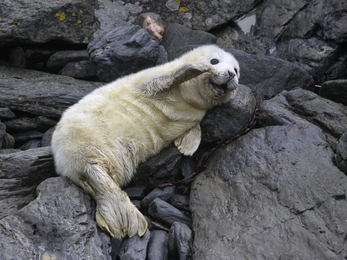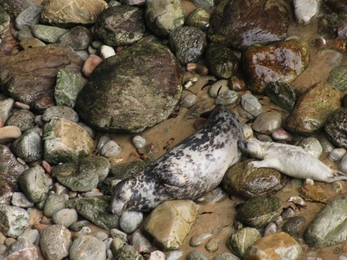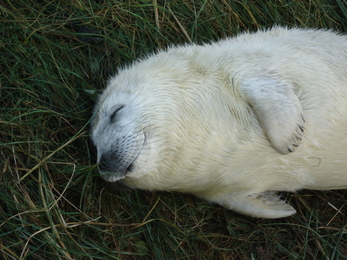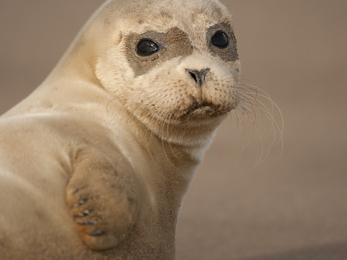Seal pups
40% of the entire world population of Atlantic grey seals make their home around the coasts of Britain, especially on the rocky northern and western shores, and islands. Having spent the lazy summer days out at sea, as winter bites the seals return to shore to give birth to their young and do their courting.
It’s not just the grey seals calling the UK coastline their home, the common seal (also known as the harbour seal) is also found on our shores year-round.
Watch the soap opera of a seal colony at its busiest
What to look for
Male grey seals (bulls) can measure up to two metres in length and weigh a whopping 300 kg in weight. Bulls will arrive on our shores before the females and stake out a territory for the winter. The females arrive soon after, looking for a quiet spot to give birth, and leading to noisy clashes between males who want to claim them for their ‘harem’. Around the UK the pupping season is between late August and January, but this varies depending on the region. On Skomer, West Wales, pups are born from late August into November whereas in Norfolk they are born from late October into January. In general, colonies reach peak activity (and noisiness) a month after the first pups are born. When grey seals are born, they have a bright white coat of fur which they need to moult before they can swim. By the end of January, the parents have left, and the last of the seal pups head seawards.
Harbour seals give birth in June and July. Unlike grey seals, their pups can swim and dive only a few hours after birth!
Keeping seals safe
When heading to see the seal pups there are a few things you need to be aware off:
-DO NOT bring your dogs. Dogs and baby seals don’t mix, and our four-legged friends can pass diseases on to seals, so leave the dog at home.
-Keep your distance. In some places during the pupping season, you will be asked to keep off the beach. This is to minimise disturbance to the seals. When distributed, mum’s often abandon their pups. Where you are allowed onto a beach, ensure you keep your distance and stay quiet to minimise the risk of disturbing the seals.
-Bring your camera and binoculars. These will help you see the seals clearly from a distance and get some amazing photographs for you to remember you seal experience.
No matter how appealing they may look, don’t touch!
Seal Spotting
You can see seals all around the British coasts. Check out our special spots below:
- Alderney, West Coast and Burhou Islands Ramsar Site
- Cumbria, South Walney Nature Reserve
- Lincolnshire, Donna Nook NNR
- Isle of Man, The Calf of Man
- Isles of Scilly
- Scotland, Isle of Eigg
- Scotland, Loch Fleet
- Scotland, Montrose Basin Visitor Centre
- Wales, Skomer
- Yorkshire, Flamborough Head
- Yorkshire, Spurn
If you can't get to these places
Grey seals live all around our coasts. Anytime you’re by the sea, keep an eye out for an inquisitive head bobbing up out of the waves. They can be told from their smaller cousin, the common seal, by their profile: Grey seals have a long sloping forehead with a ‘Roman’ nose’, like an English bull terrier, while common seals have a shorter, stepped snout and a cuter, more cat-like face.
And remember to head over to our wildlife cameras. You can see the seal colony in Cumbria from the warmth of your home and without causing any disturbance.
More wildlife experiences
From seeing colourful wildflowers to spotting magnificent birds of prey, we can help you get closer to wildlife across the UK.







